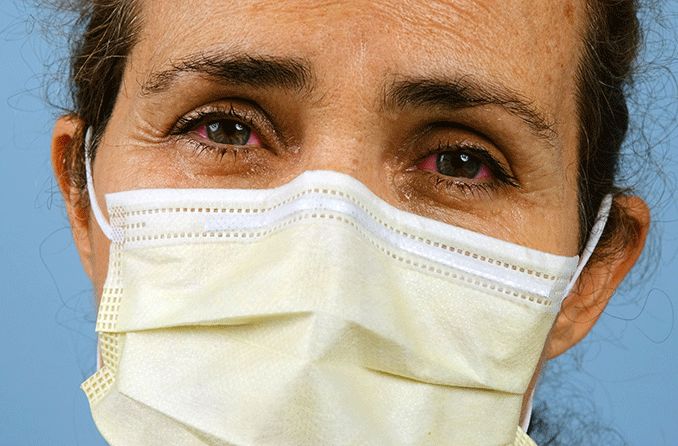Is there a connection between red eyes and COVID-19?

The coronavirus has been shown to exhibit various symptoms among patients. From a simple runny nose to organ failure, the effects COVID-19 has on the human body vary greatly from patient to patient.
One symptom that seems to remain in question is red eyes. It’s unclear whether eye redness is, in fact, a symptom of coronavirus. While having red eyes can be a symptom of the disease, the instance is rare and could be caused by something else, such as allergies or irritants.
Are red eyes a coronavirus symptom?
According to the World Health Organization, conjunctivitis (also known as red eye or Madras eye) can be a symptom of COVID-19.
In a study describing how coronavirus affects the eyes, it’s explained that SARS-CoV-2 can infect ocular tissue in the conjunctiva (the membrane that lines the inner surface of the eyelids) and cornea (the clear front surface of the eye). From there, the nasolacrimal ducts — the tunnels that drain your tears through your nose — can transmit the virus to the nasopharynx, which is the space that connects the nose and mouth.
The overall prevalence of COVID-19 patients who showed ocular symptoms is 5%, making it a fairly rare symptom of the virus.
SEE RELATED: Can coronavirus transmission happen through the eyes?
How do I know if my red eyes are from COVID-19?
The reason for red eyes may be unrelated to coronavirus. It’s possible for allergies, a common cold or a bacterial infection to be the cause of your red eyes. In order to know the difference, it’s important to look for other symptoms that may indicate coronavirus or another cause.
Other symptoms seen in people with COVID-19 include:
Fever or chills
Dry cough
Loss of taste or smell
Shortness of breath
Muscle or joint pain
Nausea or vomiting
Diarrhea
Symptoms seen with allergies that are not seen in COVID-19:
Itchy, watery eyes
Sneezing
Nasal congestion and sinus pressure
Itchy nose
Post-nasal drip, which may cause the throat to feel sore or raw
Besides allergies, a bacterial or viral infection that spreads to the eyes can cause conjunctivitis.
When proper hygiene isn’t followed, bacteria such as Staphylococcus aureus or Streptococcus pneumoniae, which often cause skin infection, can spread to the eyes and cause redness and irritation. Similarly, several common viruses, such as adenoviruses and others, can cause viral conjunctivitis.
If you notice symptoms of conjunctivitis, such as light sensitivity, thick or watery eye discharge and crusting of the eyelashes or eyelids, look for other symptoms associated with COVID-19 to determine whether the conjunctivitis symptoms are related.
SEE RELATED: A look at different types of conjunctivitis
Conjunctivitis is contagious
While it may not be as contagious as the coronavirus, Madras eye can be spread if certain precautions are not taken.
Most conjunctivitis-causing viruses are spread through contact, such as touching your eyes with hands or objects that are contaminated with the virus. Infectious tears or eye discharge, fecal matter or respiratory discharges can contaminate hands, which is why frequent hand washing is important for your health.
It’s possible to spread bacterial conjunctivitis from hand-to-eye contact, from person to person or having contaminated objects near or on the eyes. Changes in the normal bacteria that live on the conjunctiva may also trigger conjunctivitis symptoms.
Certain antibiotics and eye drops for red eyes can be prescribed to help with the symptoms of bacterial and viral conjunctivitis, which usually resolve within a week or two.
When to see a doctor
It’s possible for conjunctivitis symptoms to resolve on their own and cause no vision problems, as long as the eye area is kept clean. However, there are certain instances in which a doctor is required.
For those whose Madres eye is associated with COVID-19 and experience other severe coronavirus symptoms, such as chest pain, difficulty breathing or confusion, seek medical attention immediately. Respiratory stress is a medical emergency and should be treated quickly.
If coronavirus symptoms are not present, but you have a fever above 38°C/ 100.4°F or experience a sudden, unexplained change in vision, see a doctor.
Keeping your vision and overall health safe during these unprecedented times is important until COVID-19 finally becomes a thing of the past.
READ MORE: The COVID-19 vaccine: Will it affect your vision?
COVID-19 and multiorgan failure: A narrative review on potential mechanisms. Journal of molecular histology. October 2020.
What are the symptoms of COVID-19? World Health Organization. Accessed May 2021.
Are eyes the windows to COVID-19? Systematic review and meta-analysis. BMJ Open Ophthalmology. September 2020.
Infographic: Venn diagram of the overlap of COVID-19 symptoms with seasonal allergy symptoms. Centers for Disease Control and Prevention. September 2020.
Allergies, cold, flu or COVID-19? How to tell the difference. Emerson Hospital. March 2021.
Conjunctivitis (Pink eye): Causes. Centers for Disease Control and Prevention. January 2019.
Conjunctivitis (Pink eye): For clinicians. Centers for Disease Control and Prevention. January 2019.
Page published on Friday, 21 May, 2021





